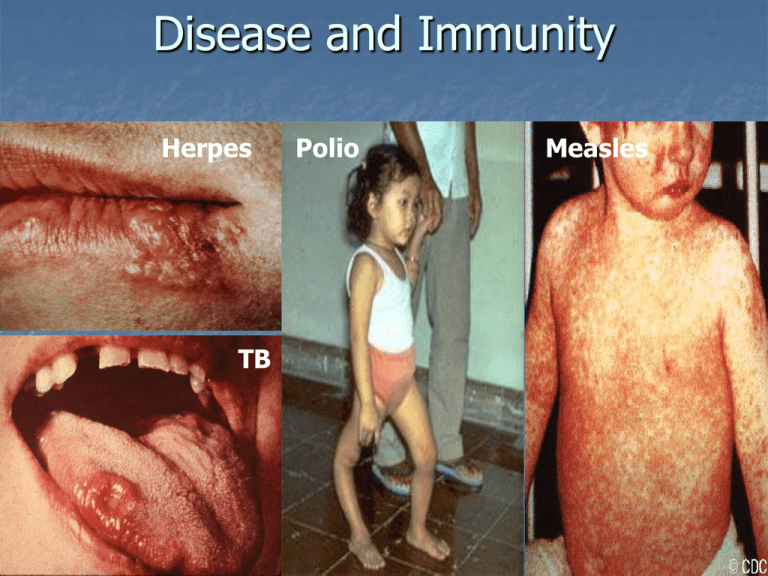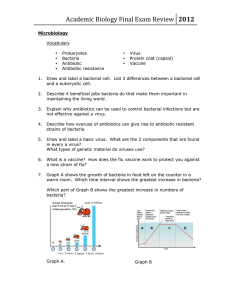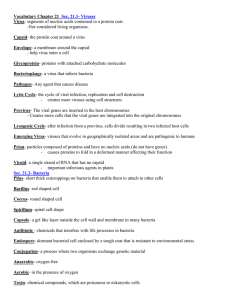Disease and Immunity Herpes Polio Measles
advertisement

Disease and Immunity Herpes TB Polio Measles Pathogens Any foreign invader that enters the body and causes disease Pathogens include: Bacteria Viruses protists A disease that can spread to others is called: Infectious Contagious communicable The Body’s Reactions The first defense is our skin and mucous membranes Sweat and oil is toxic to some bacteria Mucus will trap invaders Fever – an elevated body temperature will suppress bacterial growth and speed up our immune response Normal = 98.6 degree F / 37 degrees C The Body’s Reactions to a localized (small) infection Inflammatory response Injured cells release chemical alarm signals Capillaries respond by swelling and leaking fluid and white blood cells Swelled area is warm White blood cells arrive to attack Pus in wounds is dead pathogens Bacteria Can be pathogenic Characteristics of Bacteria How they eat Heterotrophic Autotrophic Eat other things Make their own food like plants Oxygen requirements Anaerobic Undergo fermentation (no oxygen) Aerobic Use oxygen Bacteria Classification 1. Two Kingdoms: Eubacteria – most common bacterial forms 1. 2. All pathogenic bacteria Archaebacteria – Most primitive bacterial forms that live in extreme environments Kingdom Eubacteria Most common 3 basic shapes: Rod Sphere Spiral Prefix strep = Chains Prefix staphlo = Clusters Gram staining Bacteria can also be classified by whether or not they retain color when stained by a certain chemical. Whether or not they retain the color is based on the components of their outer membrane Gram-positive bacteria retain the color (violet) Gram-negative bacteria do not retain the color and are dyed with a secondary dye which turns them pink. Different types of antibiotics are needed to treat infections based on whether the bacteria is Gram-negative or Gram-positive Some antibiotics kill bacteria by damaging their peptidoglycan cell wall Which bacteria would be resistant to an antibiotic that worked in this fashion? Bacterial diseases Tetanus Bubonic plague (The Black Death) Bacterial pneumonia Sinus infection Strep throat Tuberculosis (TB) Antibiotics and Bacteria Antibiotics only work against bacteria! Some antibiotics are made from chemicals that bacteria and fungi produce naturally Penicillin is made is from a type of fungus Other antibiotics have been created in medical laboratories Amoxicillin, Zithromax, Tetracycline, Vancomycin Antibiotic Resistant Bacteria Remember evolution 1) Bacteria have different characteristics due to mutations. 2) Some of these mutations help the bacteria to survive an attack by antibiotics. 3) The stronger (more resistant) bacteria survive and infect a new person (host). Tuberculosis Certain types of this pathogenic bacteria can no longer be treated by antibiotics How can you help to stop the spread of antibiotic resistant bacteria? Useful Bacteria 1. 2. 3. Breakdown organic matter and recycle carbon and nitrogen Help with the production of food Clean up environmental disasters Intestinal Bacteria Protists Single or multicelled organisms that live in water Plant like or animal like Three representative protists flagella Euglena eyespot Pseudopod “false foot” paramecium amoeba cilia Protist (protozoan) disease Malaria Anopheles mosquito plasmodium African Sleeping sickness Tsetse fly Trypanosoma African Sleeping Sickness The Common Cold Viruses A paothgen that is unable to grow or reproduce outside of a host cell. It is considered non-living Virology is the study of viruses Virus Structure Viruses are extremely small Capsid/ They have a : Nucleic acid (DNA or RNA) Capsid - A protein coat that protects the virus Protein tail -used to infect host Structure of Influenza Virus Glycoprotein Used to attach to host cell RNA Capsid Protein Protein Envelope Adenovirus Common cold Common cold Flavivirus Hepatitis C (non-A, non-B) Yellow fever Hepatitis Hepatitis, hemorrhage Hepadnavirus Hepatitis B virus (HBV) Hepatitis, liver carcinoma Epstein-Barr virus (EBV) Herpes simplex type 1 Herpes simplex type 2 Human herpesvirus 8 (HHV8) Mononucleosis, nasopharyngeal carcinoma Cold sores Genital lesions Chicken pox, shingles Papovavirus Human papillomavirus (HPV) Warts, cervical carcinoma Paramyxovirus Measles Mumps Parainfluenza Measles Mumps Common cold, ear infections Poxvirus Orthopoxvirus Smallpox (eradicated) Retrovirus Human immunodeficiency virus (HIV) Human T-cell leukemia virus (HTLV-I) Acquired immunodeficiency syndrome (AIDS) Adult T-cell leukemia, lymphoma, neurologic disease Rhabdovirus Rabies Rabies Herpesvirus Viruses and Their Hosts When a virus meets a host cell, it can insert its genetic material into its host, taking over the host's functions The infected cell stops producing its own proteins and starts to make new viruses! Basically, it hijacks the cell! Viral Phases Lysogenic phase - viruses are dormant inside host cells for long periods. The host is not sick. Lytic phase - The virus is stimulated new viruses are formed, self-assemble, and burst out of the host cell, killing the cell and going on to infect other cells. The host is now sick with a viral infection Viral Mutations Viruses are able to rapidly mutate Flu HIV Attacks white blood cells – the cells that protect our bodies from germs and infections HIV is latent until another infection triggers the lytic stage Kills white blood cells HIV has a high rate of replication and mutation which has made it difficult to make a vaccine Two Ways to Control Viruses Vaccination – An injection of a harmless version of a virus which causes an immune response. The body begins to produces antibodies against that virus Antiviral Drugs – Drugs that slow down or stop a viral infection Tamiflu Acquired Immunity – An immunity that develops after exposure 2 kinds: Active Immunity – When your body makes its own antibodies Getting sick vaccines Passive Immunity – Antibodies are given to the person Mother’s milk White Blood Cells (WBC) These are your immune cells Most are made in your bone marrow There are many types Lymphocytes Leucocytes Neutrophils B cells, T cells WBC that you need to know T cells Killer cells Made in bone marrow Attacks a specific pathogen B cells Made in bone marrow Attack a specific pathogen by making antibodies They stick to the surface of a pathogen and so it cannot infect any other cells Memory Cells T cells and B cells that remain in the body after an infection has been destroyed. They provide the body with active immunity in the future against that disease Your body made memory cells against chicken pox when you had it as a kid. You now have life long immunity to chicken pox! Why can’t we get life long immunity to the flu or a cold?







